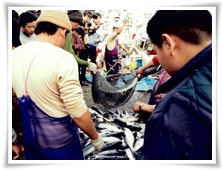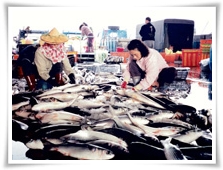 |
 |
|
 |
 |
A Brief History of Mullet |
 |
|
The scientific name for mullet is Mugil cephalus. It is a bottom-living migratory fish often giving birth roes along the southwest coast south of Hsinzhu. The spawning grounds are no farther than the Dongang and Fangliao area and the optimum growth temperature is 20 to 23℃. After the roes are hatched into small fries, they begin to migrate north when the climate gets warmer and grow up in the seabed or estuaries along the coast of mainland China.
When the cold front comes in the winter, mature mullet float to the water surface from the delta of Long River and migrate along the southwest coast of Taiwan, where the water temperature is around 20℃.To find traveling companions, they gradually swarm together and dance to the music of wedding march on the surface of the sea.
Mullet is a value fish, so Taiwan's fishermen catch this opportunity to fish mullet in the sea. If they return with a harvest, the New Year will be filled with joy. According to the experiences Cieding fishermen, ten days before and after the winter solstice every year is the best mullet fishing period. As the saying goes, "Winter is the best season of mullet; the salty fish beats the meatiest chicken.
Mullet is a good friend of Taiwan's hard-working fishermen. The fishermen often say, "mullet is the benefactor of the fishermen." They come on a fixed schedule every year, as if they are keeping their promises; therefore, they are also called the promise fish. Cieding has varied coastal topography and swarms of mullet. The record catch in Taiwan was made in Cieding's Singda Port. During the mullet season, all Cieding people talk about, busy about, and think about is mullet. The streets are paved with the bright-yellow mullet roe. This is the gold season for the fishermen, Shingda Port is Taiwan's main fishing wharf and, Cieding is the home of mullet roe.
|
|
| |
| |
 |
Cieding's Mullet Catching Techniques
|
 |
|
 Cieding has had a long history of mullet fishing. According to the history, the Han immigrants in Taiwan may have come to the island when chasing the migrating mullet swarms. In the Dutch and Ming Cheng Cheng-Kong Era, mullet fishing is levied with a special tax, and a mullet fishing license system was set up to manage the fishing rights. From this, we can see that mullet has been considered as valuable assets in the earlier times. Since the mullet swarms come and go in an instant, mullet fishing boats were granted the privilege of free access to the port. Cieding has had a long history of mullet fishing. According to the history, the Han immigrants in Taiwan may have come to the island when chasing the migrating mullet swarms. In the Dutch and Ming Cheng Cheng-Kong Era, mullet fishing is levied with a special tax, and a mullet fishing license system was set up to manage the fishing rights. From this, we can see that mullet has been considered as valuable assets in the earlier times. Since the mullet swarms come and go in an instant, mullet fishing boats were granted the privilege of free access to the port.
In the early times, the fishermen catch mullets in a crude way with rafts and simple nets. The fishermen make a noise to aruse the mullet. The mullet is especially sensitive to the knocking sound, so they jump into the net or onboard of the rafts; therefore, the Cieding fishermen call the fish the Jumping Mullet. Along the advances of technology, bell nets, pig nets, gilled nets (known as the netting methods), and spin nets have been used and become obsolete over the years. In recent years, the purse nets (also known as the tie-up nets) are gradually becoming the mainstream technique as the net can be retracted in a fairly short period of time and the fishing boats using this net is often larger, so they can stay longer on the sea.
The purse nets were invented in the United States and came to Taiwan via Japan. It requires joint operation of two fishing vessels; each grabs one end of the net. The captain keeps watch by the swarm detection device on top of the boat. When a swarm is detected, the two boats run to the opposite directions, cast nets, and draw closer the one another after the net is completely opened. The net is then retracted by the machine and pulled into a close-end purse to make sure that the catch is in the net.
|
|
| |
 |
Customs and Taboos of Cieding's Mullet Fishing
|
 |
|
 There are many customs and taboos in the Cieding area derived from the fishing activities. In the early times, the fishermen are lack of information on the weather and positions of fish swarms, so they believe in the unknown forces. Statues of deities were often brought to the warehouses during the mullet season because they believed the deities have the power to see the coming of mullets. There are many customs and taboos in the Cieding area derived from the fishing activities. In the early times, the fishermen are lack of information on the weather and positions of fish swarms, so they believe in the unknown forces. Statues of deities were often brought to the warehouses during the mullet season because they believed the deities have the power to see the coming of mullets.
The fishermen believe in the goddess of seas, Mazu, but the accompanying deities varied. Therefore, almost none of the fishing quarters enshrine the same gods. Mullet fishing is a significant event in the year, so the mullet fishing boats must first consult the gods for the date and direction of the trial run. On the trial run, the fishing boats must fire firecrackers and burn paper money as offerings to the gods and ghosts. After the end of the mullet season, the fishermen must also offer to the gods as a token of thanks for bringing them good harvest. The ones with a good harvest often offer opera shows to thank the gods.
Since mullet fishing is closely related to the livelihood of the families, the fishermen have many taboos to observe.
For example, the fishing quarter is a holy place. In the early times, the fishermen stay together in the fishing quarter during the whole mullet season. They must bathe and observe celibacy during the entire season; neither were they allowed to go into rooms of women in confinement or funerals. Moreover, Cieding's fisherman refer to the activity of patching the net as rearranging the net because a broken net is an omen for bad season. After "rearranging the net", the ceremony of joining the net must also be performed on specially selected auspicious days. After the net is joined, some people take the net to the temple and have it smoked by the incense for blessings. However, some fishermen call the net joining activities as "fortification". In addition, Cieding's fishermen call threads as yarns because thread in the Taiwanese language is a homonym of the word "scattered", and what the fishermen most afraid would be scattered mullets. Cieding's fishermen never use mullet as an offering because it is regarded as a divine creature.
|
|
| |
 |
Distinguishing Mullet Roes and the Process of Production
|
 |
|
 Mullet roe processing has had a history of several hundred years. Half of the Cieding people know how to process mullet roes. In early twentieth century, mullet roe processing expert from Nagasaki were brought in to teach mullet processing technology to satisfy the demands of the Japanese consumer market, but in fact Taiwan's businesses have been studying the technology for a long period of study and now has better technology than Japanese businesses. Mullet roe processing has had a history of several hundred years. Half of the Cieding people know how to process mullet roes. In early twentieth century, mullet roe processing expert from Nagasaki were brought in to teach mullet processing technology to satisfy the demands of the Japanese consumer market, but in fact Taiwan's businesses have been studying the technology for a long period of study and now has better technology than Japanese businesses.
The high-value mullet roes are processed through a series of labor-intensive processes: roe removal from the female fish, tying, cleaning, blood cleaning, salting, desalting, compressing and shaping, drying, and then reshaping before the precious mullet roes are ready for the market.
The mullet roe processing factories bid in the auction of mullet based on merely experience and luck. Mullet is polyandry; therefore, the rate of female and male fish is about one to three, so if a buyer wins the bid to a fish stock with more female fish, the buyer makes higher yield on the investment. Nonetheless, seminal vesicles of the male fish have also become a delicacy in seafood restaurants in recent years and the price is not too bad, either .In addition, the Stomach of mullet is also a high-class delicacy; it is often served stir-fried or smoked and deemed as a fantastic dish to go with beer.
The quality of mullet roe can be determined from the appearance. In principle, the larger the roe is the more expensive it would be. A good piece of mullet roe has nice appearance and consistent thickness. There would be no residual flesh or other attachments. Good mullet roe has neatly lined up roes and transparent yellow color. It is optimally moist with appropriate texture, so a piece of good mullet roe has superb flavor, as well as taste(according to the Cieding fishermen, in central Taiwan, mullet roe is processed with attachment to a small piece of fish meat, which is removed after it is dried; therefore, it is also known as the "flesh-cut roes". In Cieding, mullet roe is processed with attachment flesh, instead the peices of mullet is sealed with yarns. Apparently, Cieding's fishermen have better know-how).
|
|
|
 |
 |
 |
|
|
|
|
|